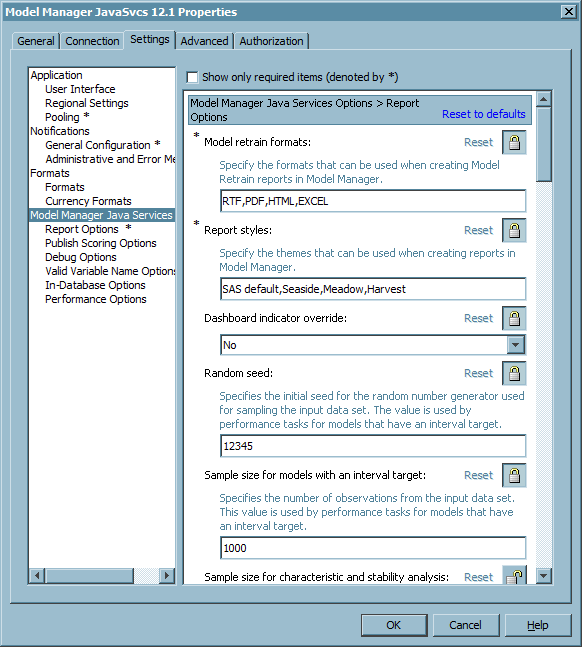Configuring Model Manager Java Services Options
Overview of Configuring Model Manager Java Services Options
The Model
Manager Java Services Options in SAS Management Console
enables you to modify SAS Model Manager configurations. The configurations
can be modified for reporting, metadata tables usage when publishing
a scoring function, SAS code debugging, SAS system options, In-database
connection and publishing options, and performance options for the
High-Performance Analytics procedure.
Report Options
The Report
Options setting in SAS Management Console enables you
to modify the SAS Model Manager configurations for the dashboard reports,
model retrain reports and performance monitoring. These reports are
available when you use the SAS Model Manager client.
-
Specify the report styles that are available when a user creates the model retrain reports and dashboard reports. You can add or remove SAS styles. The default values are SAS default, Seaside, Meadow, and Harvest. For more information about SAS styles, see Understanding Styles, Style Elements, and Style Attributes in SAS Output Delivery System: User's Guide.
Publish Scoring Options
The Publish
Scoring Options setting enables you to indicate that
the metadata tables be populated in the target database when publishing
a scoring function. The default is
Yes.
During the installation and configuration process of the database,
the metadata tables must be created in the database if this setting
is set to Yes. If you plan on only
using the SAS Embedded Process publish method to publish scoring model
files, this setting can be ignored, and you do not need to create
the metadata tables during the database configuration process.
For information
about the database configurations, see Configure the SAS Model Manager Database . For more
information about publishing models to a database, see Publishing Models to a Database in SAS Model Manager: User's Guide.
Debug Options
Valid Variable Name Options
In-Database Options
The In-Database
Options settings enables you to specify the publish type,
database connection settings, and publish settings that are used when
publishing models to a database using SAS Model Manager.
-
Specify to use the model manager table when publishing. The default value is
No. When you are publishing the scoring model files to a database using the SAS Embedded Process publish method, the files are by default stored in the table sas_model_table. If the use model manager table value is set toYes, the scoring model files are stored in the table sas_mdlmgr_ep. These tables are located in the target database. This setting provides the ability for users to segregate the SAS Model Manager scoring model files from the SAS model scoring files when using the SAS Embedded Process publish method. -
Specify to force the republish of model scoring files by default when using the SAS Embedded Process publish type. The default value is
No. If you set this setting toYes, then the Replace scoring files that have the same publish name option in the Publish Models to a Database window in SAS Model Manager is selected by default. -
Select the default format of the model publish name when using the SAS Embedded Process publish method. The format selected determines the value that appears for the publish name in the Publish Models to a Database window in SAS Model Manager. The scoring function publish method publish name defaults to the model name.
Note: The Support Netezza
SAS Embedded Process setting is set to
No by
default since with the release of SAS Model Manager 12.1 on SAS 9.3.
Therefore, the SAS Scoring Accelerator does not support the SAS Embedded
Process publish method for Netezza. When the support is made available
for SAS 9.3 this setting enables you to turn on the support for SAS
Model Manager, so that Netezza appears in the database type drop-down
list in SAS Model Manager.
For information
about the database configurations, see Configure the SAS Model Manager Database . For more
information about publishing models to a database, see Publishing Models to a Database in SAS Model Manager: User's Guide.
Performance Options
The performance options
contains the performance parameters for the PERFORMANCE statement
to use the High-Performance Analytics procedure. Currently only the
Teradata and Greenplum database types support High-Performance Analytics.
The PERFORMANCE statement
defines performance parameters for multithreaded and distributed computing,
passes variables about the distributed computing environment, and
requests detailed results about the performance characteristics of
a High-Performance Analytics procedure.
